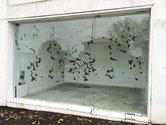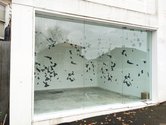John Hurrell – 19 August, 2016
Like descending autumn leaves the suspended curtain-like elements gather up in close proximity, or move apart, aiming for their own individual destinations. Because you can't enter the space you try and suss out what Shin has compressed and what she has left out from her original compositional template. How much involves Shin's creative intervention into her own initial system, and how much is the normal result of perspectival foreshortening experienced by any standing passerby positioned on the footpath?
Next door to the children’s playground on the street corner in Morningside - just before you get to the line of shops (on the other side of the street) that veers left off New North Road, towards St Lukes - there’s the lonely hollow contemporary art bunker: Jar.
You peer through its thick (tinted) plate glass window by the footpath - examining the three walls tucked in the sides and opposite, comparing sections (clusters of geometrical motifs) - allowing your eyes to rove up, down and (left to right) over the three large planes, searching for some anchoring repetition within the dark angular configurations of each wall (and across the contained space); some logical patterning that brings coherence to what looks like an explosion of shredded paper, fragments flying outward across the publically observable room. It is a sort of distant cousin to the sculptural installations of Pae White and Cornelia Parker.
In Jeena Shin’s flickering geometry, her splintered shards of positive/negative black and white, scatter across the high stud and reiterate their slivered constellations on multiple planes. Within the limitations of the natural light, they are tightly positioned in what seems to be random confusion. Slowly it dawns on you: in the middle of each wall there is an invisible dividing line where one half of ‘the chaos’ is placed alongside itself again, but inverted.
This flipping-over, bipartite system is loose with some aleatory shuffling going on, but nevertheless accurate as an approximate compositional process. The three walls are all distinctly individual, for there are different sliding sections of vertical compression and expansion. There is horizontal variation and condensation too, and sly omissions, as you’d expect with a central wall conspicuously wider than the two at the sides.
Like descending autumn leaves the suspended curtain-like elements gather up in close proximity, or move apart, aiming for their own individual destinations. Because you can’t enter the space you try and suss out what Shin has compressed and what she has left out from her original compositional template. How much involves Shin’s creative intervention into her own initial system, and how much is the normal result of perspectival foreshortening experienced by any standing passerby positioned on the footpath?
This is a complex suite of interconnected wall paintings, but not overly so. It teases via its viewing complications (the compositional system, the coloured glass, the changing inconsistent light) but is also disarmingly simple. A terrific piece of public art for all ocular-oriented, thinking Aucklanders.
John Hurrell









 Two Rooms presents a program of residencies and projects
Two Rooms presents a program of residencies and projects Advertising in this column
Advertising in this column



This Discussion has 1 comment.
Comment
Connie Blue, midnight 28 August, 2016 #
Lovely
Participate
Register to Participate.
Sign in
Sign in to an existing account.